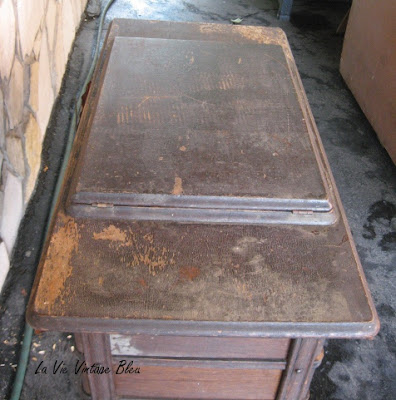Don't you just love it when you finally find inspiration to makeover something that you've been struggling with ( figuratively speaking) for ages. That's exactly what happened to me last week when I was looking at a posting on facebook from Annie Sloan. She suggested we take a look at this awesome antique sewing machine makeover from " The Empty Nest"- using Annie Sloan Chalk paint, of course. Now, you'll know if you've read one of my more recent posts that I recently discovered how to make Chalk Paint myself
( a quick recap on that later). I also happen to own an antique sewing machine in a cabinet, exactly like the one that " The Empty Nest" did, so I was doubly excited.
The picture below is the cabinet that inspired me- she called her "Coco", after Coco Chanel, since her cabinet doesn't have the sewing machine in it anymore, and Coco Chanel prefered hand sewing to machine sewing.
I've had my sewing machine for 18 years, and never did anything to fix it up. And believe me, it was in a terrible state. It is truly an antique (about 100 years old), once belonging to a great- aunt on a farm. That sewing machine made all the clothing for a family of 12, as well as many relatives and was very well used and loved. I put it in my living room, covered the badly scratched and worn top with a crocheted runner and displayed my collection of antique flow- blue china on and over it.
Not bad, but I am totally in love with " The Empty Nest" makeover, so I decided to spend this Labour Day weekend making mine look just as awesome. My cabinet is definately in worse shape, but I was up for the challenge. First order of business was to head over to Home Depot and pick up the supplies ( or in my case just pick up the supplies after work since I work at Home Depot).
Here's what you need :
*Chalk Paint in 2 colors ( recipe will follow)
Sandpaper
Painter's masking tape
Paint brush
Flat black spray paint- I used Tremclad Rust paint
Plastic drop sheets
Wood glue or Weldbond ( to fix the veneer that was coming loose on my cabinet)
Furniture paste wax
*Recipe for home made Chalk Paint- equal parts latex paint and Plaster of Paris.You might have to add a little water if it's too thick, which mine was, since the latex paint I had was old and had thickened up a lot. Yup, that's it. A blogger friend of mine saw my posting about making your own Gesso, which is chalk paint also, and gave me this even easier recipe. And it really works. She got the recipe from an antique dealer. Gotta love bloggers- we're very inquisitive people. Only costs $5.00 for a large box of plaster of paris and you can mix it with whatever color latex paint you want. If it get's too thick while you're painting, just keep adding water as you go to thin it to the consistency of thick cream.
Next I called my neighbour ( a Fireman) to help me carry the machine outside- LOL. It weighs a ton since the original Iron Lady sewing machine was still inside. Once she was safely on my driveway, I vacuumed cobwebs and dust off every bit of her, then I hosed her down. It was a very hot day, so the water dried really fast. I'm sure I broke some antique refinishing rules by doing this, but it's for my own personal use- so- OH WELL!!!!!
Here's what she looks like before the transformation:
As you can see, she's in pretty rough shape, but still a very beautiful piece of nostalgia. I'll be removing the sewing machine from the cabinet and cleaning her up too, but that will be another post, so stay tuned for that.
You can see how badly worn the top is, and some of the veneer is coming loose. And the iron bottom is pretty rusted.
After wrapping the cabinet in a plastic drop sheet to protect it , I gave the bottom 2 coats of flat black spray paint, and it looks 100% better already. And I have to say, I absolutely love the the Rustoleum ergonomic sprayer for the spray can- it really makes spray painting easy, and saves your hands from cramping. I definately recommend it- only about $7.00 at Home Depot.
Here is what she looks like with her first coat of home-made chalk paint ( Behr Cottage White mixed with Plaster of Paris), and a piece of repurposed wood nailed over the empty space where I believe a drawer once was.
I added a cut-out from some paintable wallpaper and filled the holes with spackle. I painted the drawers and edges of the cabinet, as well as the cut-outs with French Silver by Behr( also mixed with Plaster of Paris) . Then I distrressed it and waxed it with MinWax Finishing wax in natural.
Lots of buffing after that.
And ..................
VOILA!!!!!!!
Meet "Mademoiselle Chloe"
I A-B-S-O-L-U-T-E-L-Y LOVE HER!!!!!!!!
Here are some close-ups of some of the detail.
I couldn't be happier with how it turned out, and I am now a Chalk Paint lover. Of course, I will not be buying any Annie Sloan Chalk paint since it is so easy and inexpensive to make yourself.
Until next time.





























